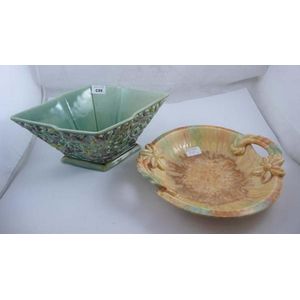Antique Chinese Rhinoceros Horn Cup
A superb antique Chinese rhinoceros horn cup, late Qing Dynasty, 19th century, in a warm honey shade, the rim embellished with a key fret band above a lappet border, further carved with two taotie masks and to one end a mischievous carved chilong clambering up the side of the cup, upon a shallow waisted stem and a raised a key fret circular foot. Height 7.5 cm. Width 13 cm. Depth 9 cm
You must be a subscriber, and be logged in to view price and dealer details.
Subscribe Now to view actual auction price for this item
When you subscribe, you have the option of setting the currency in which to display prices to $Au, $US, $NZ or Stg.
This item has been sold, and the description, image and price are for reference purposes only.
- Lappet Decoration - In the context of furniture, ceramics, and oriental wares, the word "lappet" refers to a decorative motif that consists of a repeated pattern of stylized or abstracted "lappets."
A lappet in this context is a decorative element that resembles a small, hanging flap of cloth or fabric, but rather are stylized patterns that resemble the shapes and folds of lappets. They can be found on a wide range of objects, including furniture, vases, bowls, and plates.
Lappet decoration can take many different forms, but typically consists of a series of semi-circular or pointed shapes that are repeated in a continuous pattern. The shapes may be simple or highly ornate and may be arranged in a regular or irregular pattern. The design may also include other decorative elements, such as floral or foliate motifs.
Lappet decoration is often associated with Asian design traditions, and can be found on a wide range of objects from these regions, including Chinese porcelain, where lappet decoration is often used as a symbol of abundance and prosperity, and is believed to have protective and auspicious qualities. - Qing Dynasty - The Qing Dynasty was the last imperial dynasty of China, ruling from 1644 to 1912. It was established by the Manchu people, who originated from the northeastern region of China. The Qing Dynasty was preceded by the Ming Dynasty and followed by the Republic of China.
- Ming Dynasty - The Ming Dynasty was a ruling dynasty of China from 1368 to 1644. It succeeded the Yuan Dynasty and preceded the Qing Dynasty. The Ming Dynasty was established by Zhu Yuanzhang, a former Buddhist monk who became a rebel leader and eventually overthrew the Mongol Yuan Dynasty. During the Ming Dynasty, China experienced a period of relative stability and prosperity. The government was centralized and bureaucratic, with the emperor at the top of the hierarchy. The Ming Dynasty is known for its cultural achievements, including the development of porcelain, the invention of movable type printing, and the construction of the Great Wall of China.
This item has been included into following indexes:
- Chinese silver - cups, tankards and goblets 216
- oriental carved ivory
Visually similar items

O.C. Stephens tall trough form vase, tall wavy sides, soft pink interior, printed mark to base. Height 13 cm
Sold by
in
for
You can display prices in $Au, $US, $NZ or Stg.

A large jadeite wine Pourer, fluted sides, and scalloped edge rim, 11.5 cm high
Sold by
in
for
You can display prices in $Au, $US, $NZ or Stg.

A Longquan ware shallow bowl and a flower shaped cup, 13th-15th century, the bowl heavily ported, 15.4 cm diameter and 8.5 cm diameter
Sold by
in
for
You can display prices in $Au, $US, $NZ or Stg.

Sold by
in
for
You can display prices in $Au, $US, $NZ or Stg.
